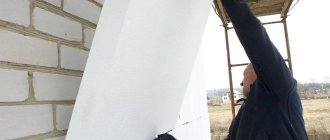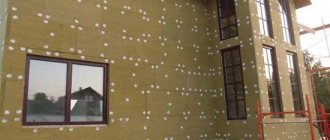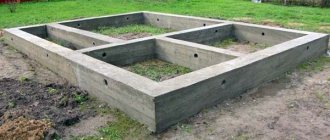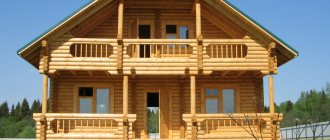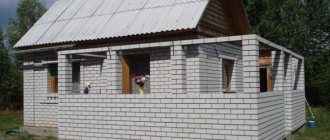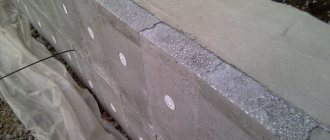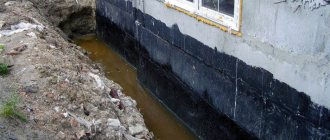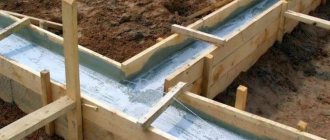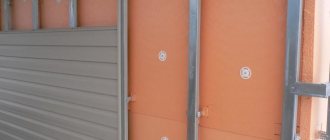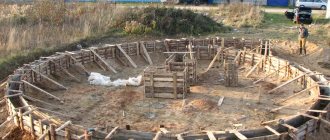Choosing insulation for the foundation
The answer to the question of how to insulate the foundation of a house from the outside is ambiguous. Modern stores offer a wide range of materials. When choosing, they are guided by the type of soil on which the building is erected, the climatic conditions of the region, as well as the degree of load on the structure. There are five insulation products that have an optimal price-quality ratio.
Expanded polystyrene
Expanded polystyrene or polystyrene foam is an inexpensive, practical material. It is widely used for thermal insulation of various structures, including foundations.
Among its advantages are:
- ease of installation;
- light weight;
- excellent thermal insulation qualities;
- foam does not absorb moisture;
- does not shrink during operation;
- does not lose its properties under the aggressive influence of salt or chlorinated water, acids, alkalis;
- it can be used together with mastics, lime, plaster and other materials.
Expanded polystyrene comes in the form of large rectangular sheets. It cuts easily with a regular knife. Therefore, even a novice master can handle its installation.
A significant disadvantage of expanded polystyrene is its low strength. It is damaged even by minor mechanical impacts. Therefore, such material needs additional protection, for example, brick lining.
For heat and moisture insulation of the foundations of houses, it is better to purchase polystyrene foam with a thickness of at least 50 mm. Its average price across the country varies from 2,500 to 3,000 rubles per cubic meter. Service life – up to 40 years.
Extruded polystyrene foam
Extruded polystyrene foam (EPS) is a type of foam. During its production, another technological process is added - extrusion. Thanks to this, the characteristics of the material are improved.
EPPS has the following properties:
- high density;
- complete impermeability to moisture and steam;
- sufficient strength;
- chemical and biological inertness.
- light weight.
To insulate the foundation, a 40 mm thick EPS slab is sufficient. It is mounted using adhesive or disc dowels.
The most popular brands of EPPS are Penoplex and TechnoNIKOL. The cost of a cubic meter of such material varies from 4,500 to 5,000 rubles. The service life, subject to installation technology, is 50 years.
Polyurethane foam
Polyurethane foam (PPU) is a liquid insulation material that is applied to the base using a special sprayer. It hardens quickly, forming a durable coating.
Compared to polystyrene foam and EPS, it has the following advantages:
- when using polyurethane foam, a continuous surface without joints is obtained, which increases the thermal insulation characteristics of the material;
- the product fills cavities and cracks that exist in the concrete foundation, which prevents its destruction;
- easy to apply on complex shaped surfaces;
- has high adhesive properties.
PPU is resistant to aggressive environmental conditions. It can withstand sudden temperature changes, does not deform, and does not release toxic substances into the air.
The price for two canisters of PU foam components weighing 50 kg each on average ranges around 25,000 - 30,000 rubles. With a layer thickness of 5 cm, this is enough to process about 40 square meters of surface. The service life of polyurethane foam is up to 40 years.
Expanded clay
Expanded clay is a material obtained from melted clay. Recently it has been rarely used, since in terms of characteristics it is significantly inferior to polyurethane foam, polyurethane foam and polyethylene foam. Its main advantage is its low price. 1 cubic meter costs about 1,500 rubles.
Expanded clay is distinguished by its environmental friendliness. Since only natural ingredients are used in its production, it does not emit any harmful substances into the air. The service life of such material is more than 50 years.
Its significant disadvantage is fragility. If the technology for manufacturing the insulating layer is violated, the expanded clay granules crumble. This worsens its thermal insulation properties. The downside of expanded clay is also the need for a blind area when laying it.
Mastics
Mastic is a liquid multicomponent composition based on bitumen. More often it is used as a base layer before laying other materials, since its thermal insulation properties are very low.
To achieve a positive result, you need to apply it in three to four layers.
The mastic well fills cracks and voids in the base, which increases the strength of the structure. It reliably protects against moisture.
Why do you need to insulate a strip foundation?
Strip foundations are used in the construction of houses on weak and heaving soils. Due to the relatively high cost, such a base is used for massive and fundamental structures. Good thermal insulation of the tape and base of the house will provide the following advantages:
- the problem of cold floors and spending on additional heating will go away;
- the heat accumulated in the house will not leave it through the uninsulated base;
- an insulated foundation and basement will reduce humidity on the first level of the building, which will leave the development of mold or mildew;
- a warm concrete base will heat the soil nearby, preventing it from freezing in winter;
- reducing the degree of freezing will reduce the degree of soil heaving, which will protect the base and walls of the house from cracks and other signs of destruction.
Many of these benefits are especially important if plans call for a shallow foundation. Consequently, the costs of manufacturing the insulating layer of the base will more than pay for themselves during the operation of the finished structure. It remains to figure out how to insulate the strip foundation.
What is the best way to insulate?
When planning work on installing thermal insulation for the foundation, the issue of choosing and purchasing suitable insulation is initially resolved. The material for foundation insulation should have the following characteristics:
- Be resistant to deformation against the background of constant pressure from the soil;
- Do not absorb moisture from the soil.
On the modern market, insulation materials are presented in a wide range, and a newcomer to the construction industry may get confused in the abundance of offers. It is worth saying that the common insulation “mineral wool” is not suitable for thermal insulation of the foundation. Not only is it not durable, but it also absorbs moisture well, as a result of which all its positive performance characteristics are negated.
Despite fire resistance and low thermal conductivity, mineral wool has a significant drawback - high hygroscopicity
In modern construction of private houses, two materials are best suited for foundation insulation:
- Penoplex;
- Polyurethane foam.
Polyurethane foam is a modern insulating material that guarantees thermal, sound and water protection of a concrete structure. The material is sprayed onto the surface using special equipment in several layers. This application technology eliminates the appearance of gaps and seams. The advantages of the material include:
- Possibility to apply thermal insulation coating without seams or gaps;
- Excellent adhesion characteristics;
- Low thermal permeability;
- Steam protection;
- Increased reliability;
- Long service life;
- There is no need to purchase additional material for steam and water protection of the foundation.
The main and rather significant drawback is that special equipment is required to lay the material, as a result of which the process becomes impossible to implement at home. In addition, polyurethane foam has a high cost.
Penoplex, in turn, does not require special skills or special equipment for installation. Among other things, it has the following advantages:
- The cellular structure does not allow moisture to pass inside, as a result of which the slabs do not collapse over time after freezing;
- Increased strength characteristics;
- Ensuring a long service life of the foundation;
- Low cost;
- Long service life of the material;
- Preservation of thermal insulation characteristics throughout the entire service life;
- Rodents do not use the material as food, unlike regular foam.
Penoplex insulation reduces heat loss by 20% and helps the foundation last longer
Penoplex is an improved version of polystyrene foam. The material allows moisture to pass through very easily, and after several cycles of defrosting and freezing it will simply crumble into segments. Let us add that several years ago, expanded clay was also in demand on the construction market as insulation for the foundation. The material is inferior to penoplex due to its high cost, as well as reduced efficiency in providing thermal insulation.
The final stage of insulation of the basement part of the foundation
There is one important point here. The walls of the house should always be slightly wider than the basement. Otherwise, water will flow from them into the cracks, which will cause not only excessive moisture in the structure, but also a breakdown in strength.
Types of base
If a mistake was made during the design or construction of the house and the base part of the foundation is wider than the wall, then additional measures will have to be taken to drain rainwater. The easiest way is to use metal canopies around the entire perimeter of the base.
Protection of the base from precipitation
Flashings for the foundation plinth
If the excess thickness is insignificant, then it is eliminated after insulation of the facade walls. And in the vast majority of cases they will have to be insulated; these are today’s state requirements for the thermal protection of buildings. And not only public, but also private houses. Building a residential building without a project is prohibited by regulations, and no one will sign the project if the latest building codes and regulations are not followed.
As for the use of dowels to fix the insulation on the base part, there are two opinions among professionals.
Dowels for thermal insulation
First, if you wish, you can drill holes and use special dowels with large heads. The practical effect in terms of the strength of the insulation will be insignificant, but it will take a lot of time and labor. We don't even take into account the cost of materials.
Second. Carefully fix all slabs protruding above the ground. If in the lower part air pockets are allowed between the slabs and foundations, then on the base part the fit should only be continuous. Is the concrete surface on the plinth too uneven? You will have to carefully scrape off all the protrusions or pre-plaster them.
Prices for popular types of plaster
Plaster
The need for thermal insulation of the foundation
Insulation of the basement foundation
Insulating the foundation of a private house with polystyrene foam from the outside is mandatory. This also applies to other buildings, especially those containing a basement. To achieve high-quality results in installing thermal insulation, many use foam plastic.
A poorly insulated building loses up to 50 percent of heat through holes in the insulating coating, causing additional economic costs for heating. A fatal mistake when installing house insulation is neglecting the thermal protection of the foundation, believing that it will be enough to just finish the walls of the structure.
Good thermal insulation of the base is characterized by two functions:
- minimizing heat consumption;
- Preservation of the foundation from freezing and deformation.
The fact is that the predominant type of soil in our country is heaving. Due to the effects of cold, the depth of soil freezing can be several meters. During a thaw, the volume of soil changes, which in turn negatively affects the structure of the foundation of the house.
Before starting installation work, it is necessary to take into account that the installation of the thermal insulation coating must be complete. The presence of any cracks, defects and parts in the insulation layer has a detrimental effect on the building’s ability to maintain a temperature suitable for comfortable living. Only a dense air layer containing an insulation ball can completely contain the loss of warm air.
Advantages of slab insulation
Polystyrene foam, polystyrene foam, and polyurethane foam are used as thermal insulation materials. Mineral wool is not suitable due to its low strength and high degree of moisture absorption.
There is a technology for installing a Swedish stove. The main difference is that the concrete structure is built on a layer of heat-saving material, thanks to which the soil under the house does not freeze or heave.
The main advantages of the Swedish stove are:
- the construction of the foundation and the laying of communications are carried out in one technological cycle;
- the heat-saving layer allows you to increase the efficiency of the heated floor;
- installation of the foundation is carried out without the involvement of a large amount of construction equipment.
A drainage system consisting of pipes for draining rain and melt water is provided around the building.
The design of the slab helps to transfer all the loads from the building to the layer of heat-saving material, therefore increased demands are placed on the materials used.
What is extruded polystyrene foam
Not everyone clearly understands what polystyrene foam actually is. In general, this is nothing more than ordinary and well-known foam plastic, used in everyday practice, mainly for packaging fragile items. This is a durable, lightweight, heat-saving, biodegradable and almost insoluble material obtained by filling styrene granules with gas and then heating them.
When exposed to temperature, the granules “swell” until they occupy the entire volume available to them and sinter together.
Extruded or extruded polystyrene foam is distinguished by a special manufacturing technology. For ordinary polystyrene foam, polystyrene granules are simply heated with water vapor, while to obtain EPS, several processes are used at once: the granules are mixed and heated, a foaming agent is introduced, and then extruded under high pressure, i.e. pushed through the molding hole.
This technology provides greater uniformity and, therefore, greater strength of EPS compared to foam plastic.
Foam insulation
External insulation of the foundation of an already operating house using polystyrene foam requires a number of preparatory measures. First of all, a layer of soil is removed to the depth of freezing of the ground. The substrate is thoroughly cleaned of debris and soil residues. Next, waterproofing work is carried out.
Waterproofing
It is rational to use bitumen in rolls or liquid rubber as waterproofing. First, the foundation substrate is primed. To do this, molten bitumen or rubber is mixed with diesel fuel in a 1:1 ratio, after which the surfaces are primed with the mixture.
After the substrate has dried, the selected waterproofing is applied directly to the outer surface of the house foundation. If molten rubber can be applied with a spatula or brush, then the underside of the rolled bitumen will have to be heated with a burner and only then attached to the foundation.
Installation of insulation
After completing the preliminary waterproofing work, you can proceed to the installation of foam plastic. Here you will also need to use a torch. With its help, the surface of the waterproofing material is heated, after which the foam sheets are attached. As an alternative, special mastic can be used for reliable fastening.
Having laid the foam with your own hands, it must be covered with soil. It should be noted that before backfilling the material, it is necessary to first install a layer of roofing felt between the soil and the foam. This avoids damage to the insulator by moisture and small pests.
A little about the product
Extruded polystyrene foam is an analogue of foam plastic, consisting of small edges. Production involves foaming the material using agents, which can be freon or carbon dioxide. Numerous tests have confirmed the negative impact of the former on the Earth's ozone layer. In this regard, manufacturers are increasingly trying to produce polystyrene foam using CO₂. The granules themselves are obtained by passing the mixture through a special matrix with small cells. As a result, finished sheets and panels are formed. This form was not chosen by chance, since laying extruded polystyrene foam in the form of small slabs is much easier and more convenient.
Thermal insulation of the blind area
Insulation of the soil around the building is used to protect it (the soil) from heaving and reduce the depth at which the foundation is laid. Expanded polystyrene prevents deformation. This increases the reliability and durability of the base.
How to properly insulate a blind area
Optimal design of blind area insulation
Thermal insulation of the surface begins with vertical laying, after which the sand is poured back 15 cm below the ground level. The formwork is carried out at a distance of about a meter from the wall, the bottom is leveled and compacted. After this, the slabs and waterproofing film are laid and the concrete is poured. It needs to be leveled so that there is a slight slope towards the outside. If the concrete has hardened, the formwork is removed and the blind area is finished with stone or paving slabs.
Insulation of the blind area
Preparatory stage
Expanded polystyrene PSB-S
First you need to calculate how many insulation boards will be needed for the foundation. The dimensions of a standard polystyrene foam board are 600x1200 mm, thickness from 20 to 100 mm. For the foundation of a residential building, slabs 50 mm thick are usually used, laid in two layers. To find out how many slabs will be needed, the total length of the foundation is multiplied by its height and divided by 0.72 - the area of one sheet of polystyrene foam.
For example, if a 2 m high foundation is insulated in a 10x8 m house, the thermal insulation area is equal to 72 square meters. Dividing it by 0.72, we get the number of sheets - 100 pieces. Since the insulation will be carried out in two layers, it is necessary to buy 200 slabs 50 mm thick.
This, however, is a very average calculation, based on the fact that the insulation thickness will be exactly 100 mm. But this value can be greater - it all depends on the climatic conditions of the region, the foundation material, and the type of insulation.
There is a special system for calculating thickness, which requires knowing the R index - this is a constant value of the required heat transfer resistance established by SNiP for each region. You can check it with your local architecture department, or take it from the table below:
| City (region) | R – required heat transfer resistance m2×°K/W |
| Moscow | 3.28 |
| Krasnodar | 2.44 |
| Sochi | 1.79 |
| Rostov-on-Don | 2.75 |
| Saint Petersburg | 3.23 |
| Krasnoyarsk | 4.84 |
| Voronezh | 3.12 |
| Yakutsk | 5.28 |
| Irkutsk | 4.05 |
| Volgograd | 2.91 |
| Astrakhan | 2.76 |
| Ekaterinburg | 3.65 |
| Nizhny Novgorod | 3.36 |
| Vladivostok | 3.25 |
| Magadan | 4.33 |
| Chelyabinsk | 3.64 |
| Tver | 3.31 |
| Novosibirsk | 3.93 |
| Samara | 3.33 |
| Permian | 3.64 |
| Ufa | 3.48 |
| Kazan | 3.45 |
| Omsk | 3.82 |
Calculator for calculating the thickness of foundation insulation
In order not to bother the reader with calculation formulas, below is a special calculator that will allow you to quickly and accurately find the required thermal insulation thickness. The result obtained is rounded up, leading to the standard thickness of the panels of the selected insulation:
In addition to polystyrene foam you will need:
- mastic or roofing felt;
- gravel;
- glue;
- mushroom dowels;
- putty or polyurethane foam;
- level;
- notched spatula;
- cement mortar;
- sand;
- reinforcing mesh;
- roller
When all the materials have been prepared, a trench is dug along the perimeter of the foundation. You need to dig to the freezing level, that is, to a depth of 1.5-2 m. To make it convenient to work in the trench, its width should be 0.8-1 m. Of course, soil excavation is carried out exclusively by hand, since equipment can damage the foundation. The walls of the base must be thoroughly cleaned of soil, unevenness and cracks must be repaired with mortar.
Types and characteristics of EPS
For some time now in Russia extruded polystyrene foam has been called by the name of the company that produces this material. This is how Penoplex, Technoplex, TechnoNIKOL and Ursa appeared. Well-known companies, TechnoNikol and URSA Eurasia, supply high-quality thermal insulation to the construction market.
Penoplex
Especially for underground structures and structures, the company produces a type of insulation called Penoplex Foundation. The manufacturer guarantees increased strength and ability to withstand loads for 50 years. The declared characteristics of this insulation are characteristic of EPS, however, the thermal conductivity coefficient is slightly higher - 0.03-0.032 W/m*ºС.
The sheets have dimensions of 1200x600 mm with a standard thickness of 20 to 150 mm. The average cost of one sheet 50 mm thick is 199 rubles.
Watch the video to see how this type of material is used for insulation.
TechnoNikol
For insulation of slab foundations, the TechnoNIKOL CARBON ECO SP brand of EPPS is produced. It is characterized by strength, stability in a biologically aggressive environment, and thermal inertia. Service life – 40 years.
The company produces one standard size of this brand - 2360x580x100 mm. The price of one sheet fluctuates around 740 rubles.
We recommend watching a video on how to insulate a base using this material.
URSA Eurasia
The company produces three grades of URSA XPS extruded polystyrene foam. The most suitable for foundation insulation is URSA XPS NV, since it has the highest compressive strength - 50 t/sq.m. m. However, the temperature regime has been reduced: from -50 to +75.
URSA calls its products slabs, and the dimensions of this material are as follows: 1250x600 with a thickness of 50.60, 80, 100 mm. The cost of one slab with a thickness of 50 mm is 192 rubles.
The use of expanded polystyrene for exterior work requires reliable sealing with cement-based plaster mixtures.
Why is Penoplex the best solution for insulating the foundation of a house from the outside?
Before you begin insulation, you should take care of purchasing a high-quality and durable heat insulator. Insulating the foundation of a house from the outside with polystyrene foam, the price of which is lower than Penoplex, is not economically profitable. Such material will not serve the structure for more than 5-7 years, which means you will have to spend money on dismantling and re-insulating it. Choose modern insulation, the quality of which has been tested by time - improved Penoplex polystyrene foam, made by extrusion.
- The popular extruded polystyrene foam is a 100% moisture-resistant material, so it does not require additional waterproofing from groundwater.
- The thermal conductivity coefficient of PenoplexFundament or PenoplexGEO slabs is 0.03 W/m°C, which is 33% more efficient than traditional polystyrene foam, so you will need 1.5-2 times less insulation.
- The increased strength characteristics of expanded polystyrene are 3 times higher than polystyrene foam, and therefore guarantee reliable protection of waterproofing from damage.
- The insulation retains its performance properties even in extreme conditions of the Far North or constant exposure to moisture.
- The service life of Penoplex is almost 10 times higher than its foam counterpart, so the material will more than pay off every penny spent in just a couple of heating seasons.
Technical characteristics of PENOPLEX
| Physical and mechanical properties | Technical standards | Unit change | "PENOPLEX" | |
| Compressive strength at 10% linear deformation, not less | GOST EN 826-2011 | MPa (t/m2) | 0,20 (20) | |
| Static bending strength | GOST 17177-94 | MPa | 0,25 | |
| Water absorption in 24 hours, no more | GOST 15588-86 | % by volume | 0,4 | |
| Fire resistance category | FZ-123 | group | G3 (with fire retardants) | |
| Thermal conductivity coefficient λlab. | GOST 30256-94 | W/m∙ºK | 0,033 | |
| Standard sizes | thickness | TU 5767-006-54349294-2014 | mm | 20, 30, 40, 50, 60, 80, 100, 120, 150 |
| width | 600 | |||
| length | 1200 | |||
| Operating temperature range | TU 5767-006-54349294-2014 | ºС | -100….+75 |
Depending on the type of foundation, the optimal technology for insulating the foundation from the outside is selected. Let's take a closer look.
Types of material
Expanded polystyrene appeared at the beginning of the 20th century and was patented in 1928. This is quite an interesting material, widely used in construction. The main quality is the ability to retain heat.
Many people consider expanded polystyrene and polystyrene foam to be the same material, which is incorrect. It differs from polystyrene foam: it is more durable, resistant to external influences, and homogeneous. Its cost is higher than that of conventional foam.
Expanded polystyrene is produced by adding gas to the polymer mass. When heated, it increases. Depending on the type of material, different gases are used. Simple forms of the material are created from naturally occurring gas. More complex ones are filled with carbon dioxide.
Types of expanded polystyrene:
- Pressless is the most common type. Drying removes all moisture. Next, at a temperature of 80 degrees, foaming occurs, followed by drying and heating. The finished mixture is poured into a mold where the polystyrene foam hardens. Obtained by this method is considered brittle. Its preparation requires less isopetane, which makes the final cost of the product affordable for most.
- Extruded – similar with a pressless appearance. The difference is in the use of equipment. In this case, an extruder is used, after which the type of material is named.
- Extrusion is created as a result of processing the final mass. Used for preparing disposable tableware and packaging.
- Pressing is the most expensive method of creating expanded polystyrene. After foaming the mass, processing with a press is provided. This makes it more durable and strong.
- Autoclave is less common. Manufacturing takes place in an autoclave.
Varieties of expanded polystyrene
Each type has its own advantages that distinguish it from the rest. The safety aspect for humans is important.
Insulating the foundation using polystyrene foam
Polystyrene foam is not capable of collapsing when in contact with asphalt or paving slabs.
Among the many insulation materials for foundations, including mineral wool, glass wool and expanded clay, the most suitable material should be noted - polystyrene foam. Due to its ability to maintain its functions in any climatic conditions, the product has gained incredible popularity among builders.
The characteristics of polystyrene foam are reliability, low cost and ease of use. In addition, its main component is air, which itself has excellent thermal insulation properties.
Foam plastic for foundation insulation has the following properties:
- stability when interacting with asphalt and concrete;
- resistance to water and fire;
- ability to retain heat;
- resistance to temperature fluctuations;
- maintaining shape and volume when exposed to external factors.
A significant disadvantage of polystyrene foam is fragility. To prevent the formation of various defects on it, the surface should be treated with glue.
Polystyrene foam is recommended for insulation of foundations built on clay soil. In addition, it is an excellent insulation option designed for underground use. This is due to its good moisture resistance and resistance to sudden temperature changes.
Types of foam plastic for insulating the foundations of houses:
- press - plate, foam thickness - from two centimeters;
- tiled polystyrene foam, parameters – 1*1*0.05 m;
- polyurethane foam (liquid);
Most often, foam is used for insulation. The reason for this choice is its size, which has a beneficial effect on installation and finishing procedures.
Insulation of columnar and pile foundations
Do-it-yourself insulation of a foundation of columnar and pile type has its own characteristics. You will definitely need to make a pickup.
Features of insulation of a columnar base:
- You need to dig a trench between the pillars and the foundation. It is filled by a third with sand and crushed stone.
- Then reinforcement and pouring with concrete are performed.
- Further along the perimeter of the pillars, brickwork is made. It is necessary to provide holes for ventilation.
- After the masonry has dried, the insulation can be fixed. Then plastering and backfilling is done.
At the final stage, you can perform decorative lining of the base. For this you can use stone, painting, plaster.
Foundation thermal insulation
The use of modern methods of thermal insulation is of great importance, especially in areas with harsh climatic conditions. This prevents a significant portion of heat loss and freezing of soils, which increase in volume, which leads to a rise in their level.
Foundation insulation with polystyrene foam
Insulating the foundation of a house from the outside with polystyrene foam is an excellent option for improving the thermal insulation qualities of the base of the house and preventing freezing.
Expanded polystyrene is an improved type of foam. Its use is more profitable, and installation is easier.
The video describes in detail how to insulate the base of a residential building with your own hands.
The process works as follows:
Preparing the base. This stage can be carried out both during the construction of the building and after its completion. To do this, you need to dig out the foundation, clean it of soil, debris, rust and grease. Sheet selection
In this case, you need to pay attention to two factors: density and thickness. They mainly use sheets with fire retardant additives and a density of 35 kg/m3. Waterproofing
This will prevent the influence of groundwater and its penetration through the insulator layer. Fastening polystyrene foam sheets with contact adhesive. You can attach two layers, but so that the panels of the second layer cover the joints of the first. Protection of insulation with a reinforcing mesh to avoid strong mechanical stress and the penetration of rodents. A layer of cement mortar can be applied to the protective mesh. Providing drainage. This step is considered mandatory when constructing a building on wet soils. Basement insulation. The base also needs to be insulated in the same way, followed by finishing. After the glue has dried, the panels are additionally secured with nails. Soil insulation. The event involves isolating the surrounding land with a blind area insulated with polystyrene foam slabs.
Knot
Insulating the foundation and blind area can significantly increase the temperature in the structure and protect the foundation from destruction.
Insulation of the foundation with liquid polyurethane foam
It is considered a fairly effective method that reduces heat loss by 20–25%.
To do this, two liquid components are mixed with each other, forming a thick foam. When applied, it increases in volume and hardens, forming a protective seamless layer with excellent thermal insulation and waterproofing properties. The optimal application thickness is considered to be 60 mm.
Wooden building
The polyurethane foam layer can be applied at a temperature not lower than +5 C. Surface preparation involves cleaning from contaminants, and surface quality is an unimportant factor.
As the foam hardens, it changes color. When performing work, various problems may arise related to equipment and neglect of weather conditions.
For example, when applied in sub-zero temperatures, cracks may appear that must be repaired in the future, otherwise water may accumulate in them and freeze. After polymerization, the polyurethane foam layer has low plasticity.
Incision
Foundation insulation using EPS
As a rule, not all insulation materials are suitable for thermal insulation of the base. To choose the right material for this purpose, you need to consider its service life: it must be as durable as the building itself.
Insulation with extruded polystyrene foam (EPS) is considered a more reliable method than, say, polystyrene foam, since this material is more durable and has excellent performance characteristics.
Blind area with trays
For this purpose, you need to purchase heat insulation boards and suitable glue for attaching it. After this, a number of preparatory activities should be carried out:
- Dig a trench around the foundation, digging into the ground.
- Apply EPS to the freezing depth of the ground.
- Clean the foundation from debris and dirt.
- Apply a special primer in two layers, wait for it to dry and absorb into the concrete.
- Provide waterproofing with bitumen mastic.
- Apply glue to the boards.
Attaching the slabs to the outer part of the foundation is allowed 1 minute after applying the glue. If the panels have a large area, you need to apply the glue in several strips using a comb spatula. If the slabs have locks, then a few days later the seams are sealed with polyurethane foam, and the slabs themselves are additionally secured with dowel nails.
Two-story mansion
Gluing the foundation tape
The process of insulating a pre-prepared foundation
The depth of insulation is an important criterion; it is advisable to insulate the entire concrete surface in the ground, but not less than 60 cm (over the entire width of the sheets). Less depth will not give the desired result. The thickness of the sheet when insulated with penoplex should be 50-60 mm.
The work technology allows you to do all the work yourself. After stirring the glue in a low container according to the instructions, apply it to the sheet with a notched trowel in an even layer of 6-10 mm. In this case, point fastening cannot be used; the properties of the heat-insulating adhesive will be lost.
Start from the corner, first fit two empty sheets and make vertical marks, monitoring the connection of the lock along the corner. Then they smear and glue both sheets, glue the side of the foundation halfway, and then from the second corner, in a circle. The sheets usually meet in the middle of the strip foundation. Make sure that when pressed, air should come out; apply force from the center of the sheet to the edges. Gradually putting him in his place.
Basement insulation with penoplex
Technology for insulating the base in the same plane as the walls of the house:
- Marking. Since the insulation boards should be several centimeters higher than the waterproofing layer, horizontal markings should be made with a pencil along the entire surface of the wall.
- Cleaning the outside of the wall. The wall surface is pre-prepared for gluing with polystyrene foam. To do this, it is thoroughly cleaned from the outside of dust and dirt. After this, the surface is primed. After the primer has dried, you can proceed to the next step.
- Connecting slabs. Pasting the walls of a house with polystyrene foam is done using special glue, starting from the corner. The slabs are marked and cut with a sharp wallpaper knife.
- Applying glue to the wall and slabs. Using a special notched trowel, the adhesive is applied to the surface of the base. Pre-prepared fragments of slabs are smeared with glue and attached to the wall, the joints between the slabs and the ends outside the house are carefully sealed.
- Next, using a hammer drill, dowels are drilled and inserted, followed by driving in nails. After covering the entire surface of the outside of the house with slabs, a special primer layer is applied to provide the basis for all subsequent layers.
- Strengthening the slope angle. A metal corner is attached around the entire perimeter of the wall. For installation, the same adhesive is used as for the slabs.
- Installation of reinforcing mesh. The reinforcing mesh is pre-cut to the size of the slabs, lubricated with adhesive and glued on top of the polystyrene foam. The technology for strengthening the reinforcing mesh is the same as for installing the corner.
- Finishing work and installation of drip linings. Materials for external work are used to putty the base area. It is left to dry and primed again followed by painting. To prevent moisture penetration, flashings are installed.
If coating defects occur, they can be easily eliminated by re-priming and painting. The technology of thermal insulation with foam plastic is the same as that of penoplex.
Applications of modern materials
Comparison of the effectiveness of various insulation materials
There are many insulation materials on the market and their use is widespread, but experience in the construction of private cottages has shown. Penoplex and extruded polystyrene foam occupy a leading position. Dimensions can vary from 50*1000 to 1000*1000 mm. with a sheet thickness of up to one hundred millimeters.
Let's consider its advantages and disadvantages:
- Moisture absorption up to 3.1% per cubic meter.
- Density (up to 45 kg per m 3), which allows heavy finishing work to be done on top of it, such as plastering and tiling. An excellent option for insulating the basement part of a strip foundation.
- The durability stated by the manufacturers for 50 years can be used outside without fear.
- Penoplex or expanded polystyrene is easy to work with; the weight of one cube is 25-35 kg. It can be cut with a construction knife without much effort; no additional equipment is needed.
Penoplex has one drawback - when burned, it releases phenol, a carcinogen. But production technology has stepped forward and now the flammability class of this material has increased to A-1 (non-flammable and slightly toxic). It is advisable to store a new, freshly made sheet in a well-ventilated area.
When preparing insulation with polystyrene foam, the material must be prepared. It is cleaned with sandpaper for better adhesion to the concrete surface. Priming the sheets will also not be superfluous.
Why is it necessary to insulate the foundation?
Under the influence of low temperatures, the soil begins to move, which is why small cracks appear in the material from which the foundation is made. Groundwater enters such pores and, freezing, expands them, which leads to the gradual destruction of the base.
To avoid such consequences, the foundation is insulated during the construction stage. You can install insulating material after the house has been in use for some time. In order for the thermal insulation layer to last for a long time, it is covered with finishing materials. This design serves as a barrier against the effects of:
- Moisture.
- Temperature changes.
- Mechanical type.
In addition, thermal insulation retains heat indoors, which means you can spend less on heating your home and still have a pleasant microclimate.
Selecting a thermal insulator
To insulate the foundation of a house from the outside, it is important to select a material whose properties are most suitable for the building, taking into account all its features and the climatic conditions of the area. Today, the following are especially popular among many consumers:
- expanded polystyrene;
- liquid polyurethane foam;
- extruded polystyrene foam.
Expanded polystyrene
It is an improved version of polystyrene and its derivatives and is a gas-filled material. Widely used in various branches of construction and industry.
Penoplex installation
The main advantages are:
- Low degree of thermal conductivity. Allows you to keep the room warm. For example, a material 11 cm thick gives the same results as a two-meter brick wall.
- Waterproof. Moisture absorption is about 6%, which allows the material to be used in conditions of high humidity without fear of deformation.
- Long service life. Withstands up to 60 cycles of operation in temperature conditions from -40 to +40 C.
- Insensitivity to biological effects. The material is not exposed to microorganisms, mold and fungi.
- Environmental friendliness. During production, substances that are harmless to human health and the environment are used, so expanded polystyrene is also used in the food industry.
- A light weight. Thanks to it, the insulation of facades becomes labor-intensive and does not take much time.
- Heat resistance. When ignited, fire-resistant types of polystyrene foam tend to self-extinguish.
- Soundproofing properties. This is especially important for owners of houses and apartments in noisy areas. The use of 3 cm thick polystyrene foam sheets for insulation can reduce noise by 25 dB.
- Vapor tightness. The indicator depends on the density and structure of the type of polystyrene foam. Varieties with low vapor permeability are similar in this indicator to certain types of wood: pine, oak.
- Chemical resistance. The substance is not subject to the aggressive effects of ethers and alcohols, but is destroyed under the influence of solvents.
- Resistance to mechanical stress. Mechanical strength during tension is approximately 20 MPa.
- Relatively low price, which increases the availability of the material for many consumers.
Wiring diagram
So, expanded polystyrene is an ideal option for use for various purposes, especially for thermal insulation of the foundation.
Liquid polyurethane foam
Liquid polyurethane foam is a polymer insulation material that is widely used to obtain a uniform insulating coating.
This is one of the few materials that are simultaneously a thermal insulation, vapor barrier and waterproofing layer. They allow you to significantly save money and labor costs when performing thermal insulation work.
In the context
The advantages of liquid polyurethane foam are:
- Low degree of thermal conductivity. This allows you to significantly reduce heat loss.
- Long service life. The service life is more than 30 years.
- The ability to create a favorable microclimate in the room due to optimal thermal conductivity and sound insulation.
- Considerable strength. Due to its good density and strength, the material is able to withstand large mechanical loads without losing its performance properties.
- Absolute sealing, which is very important when performing any type of insulation work.
Liquid polyurethane foam
Thermal insulation of the foundation using liquid polymer can be carried out both from the inside and from the outside. For external use, additional protection from direct sunlight may be required.
Protection is carried out by applying liquid rubber or facade paint, which prevents the loss of waterproofing properties and increases service life.
Extruded polystyrene foam
It is a relatively young type of polymer heat insulator and is produced by foaming raw materials during the extrusion process. Due to a number of advantages, the material has won the trust of many consumers and today is widely used in various fields of construction.
Formwork for blind area
The advantages of the material are:
- low water permeability;
- low thermal conductivity;
- resistance to mechanical loads;
- resistance to chemical attack from inorganic solvents;
- ability to withstand a wide range of temperature changes: from -50 to +75 C;
- long service life;
- a light weight.
Installation drawing
Extruded polystyrene foam is widely used for internal and external insulation of buildings, roofs, is an integral part of sandwich panels, etc. One of the most common varieties is penoplex.
Insulating the foundation from the outside with penoplex is relevant and popular due to its excellent performance qualities. Such slabs have increased strength and can withstand enormous loads, providing excellent waterproofing and drainage of groundwater.
Finishing
Do-it-yourself thermal insulation of the foundation with penoplex allows you to solve several problems related to the construction of the foundation and equipment of the basement.
Thermal insulation of a columnar foundation with polystyrene foam
Before you insulate a columnar foundation with your own hands, you will need to purchase a heat insulator and suitable glue for it. Then you should perform all the following types of operations in turn:
- Dig the foundation to its depth, making a trench around it.
- Cover the foundation with EPS at least to the depth of freezing of the soil.
- Clean the foundation, removing all crumbling or chipping concrete particles.
- Cover the surface of the foundation with a penetrating primer (2 layers) and let it dry until it is completely absorbed into the concrete.
- Waterproof the foundation with bitumen mastic.
- Apply glue onto the slab in spots.
The polystyrene foam is attached to the foundation 1 minute after applying the glue. If the size of the polystyrene board is 120x60 cm, you need to apply more than 8 strips of glue 1 cm wide. For this, a comb spatula is used. You need to start from the bottom, rising in rows.
If the polystyrene foam insulation does not have special locks, then after 3 days polyurethane foam is injected into the seams between its plates for sealing. Dowels can be used for fastening, so holes for them are drilled along the edges of the slabs and in the center of each of them.
When insulating a columnar foundation with your own hands, coating waterproofing can be used if protection from capillary water is required. The level of hydrostatic pressure can reach up to 0.1 MPa.
The technique of coating waterproofing is quite simple. It is performed using bitumen or polymer mastics that cover the surface of the foundation with a film with waterproof properties. The use of coating technologies is typical for vertical waterproofing of foundations.
When carrying out horizontal coating waterproofing, it is necessary to take into account the fact that due to their low strength they are used only as auxiliary waterproofing layers. After treating each hole with a small amount of foam, dowel nails are driven into them. Then waterproofing is applied to the heat insulator with polymer mastic, and after it dries, the trench is covered with earth.
